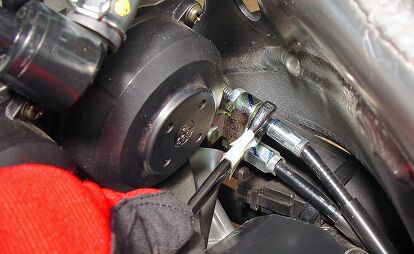How To Adjust Throttle Free Play and Why

Essential for smooth throttle control
One hallmark of a skilled rider is the ability to precisely deliver the right amount of throttle at the right time. Smooth transitions on and off the throttle play a vital role in keeping the chassis stable in a corner. Since the throttle cables are still, for the majority of bikes, the direct link between your hand and the butterfly valves in the mixers, minimizing slop in the system will pay big dividends.
To check the throttle free play, hold the grip between your fingers and roll it back and forth until you begin to feel the pull of the cable. Pick a spot on the grip and watch it to measure the free play. If you have trouble visualizing the measurement, hold a metric tape measure up to the grip. Most factory manuals will tell you that 2–3mm is the correct amount of throttle free play.
Once you’ve determined if the free play needs adjustment, loosen the cable’s locking nut(s) near the throttle grip. Some bikes will only have one adjuster. For two-adjuster models, loosen the nuts until there is plenty of slack. Next, tighten the deceleration adjuster (the cable that pulls the grip into the throttle-closed position) so that there is no slack when the throttle is held closed. Tighten the deceleration locking nut. Now, adjust the acceleration cable’s adjuster until the desired amount of free play is present in the grip and tighten its locking nut. Ensure that there are plenty of threads (at least three) engaged in the adjuster body.
If you can’t get the proper amount of free play with the adjusters, you’ll need to take up some slack down by the throttle bodies. So, set the adjuster back into the middle of its range before making any changes by the throttle body’s bell crank. The lower cable adjustment involves loosening the cable’s lock nut, making the change to the adjustment nut, tightening the lock nut back in position, and rechecking the throttle free play. Fine-tuning can take place with the adjuster by the grip.
Food for thought: While 2–3mm free play may be the factory spec, many riders prefer even less free play, giving them the feeling of a seamless connection to the carburetors or injector housings. Experiment with different free play amounts to find the setting that suits your riding style.
A word of warning about using less free play than the factory specifies: If the throttle cables are too tight, they can cause the throttle to stick or not close completely, so check thoroughly by rolling the throttle open and releasing it from a variety of settings and handlebar positions. Finally, run the engine at idle speed and turn the handlebar to both the right and left to make sure that the engine speed does not change. If it does, check the cable routing and free play again.
This project was adapted from Evans Brasfield’s books 101 Sportbike Performance Projects and How To Modify Your Metric Cruiser.

Like most of the best happenings in his life, Evans stumbled into his motojournalism career. While on his way to a planned life in academia, he applied for a job at a motorcycle magazine, thinking he’d get the opportunity to write some freelance articles. Instead, he was offered a full-time job in which he discovered he could actually get paid to ride other people’s motorcycles – and he’s never looked back. Over the 25 years he’s been in the motorcycle industry, Evans has written two books, 101 Sportbike Performance Projects and How to Modify Your Metric Cruiser, and has ridden just about every production motorcycle manufactured. Evans has a deep love of motorcycles and believes they are a force for good in the world.
More by Evans Brasfield

































Comments
Join the conversation
With hydraulic clutches, throttle play and learning how to hit it just right so there's no noticeable shift takes concentration & practice. These adjustment tips should help. Thx
You could also make a little reference mark on and next to the grip so you can more accurately measure free play.